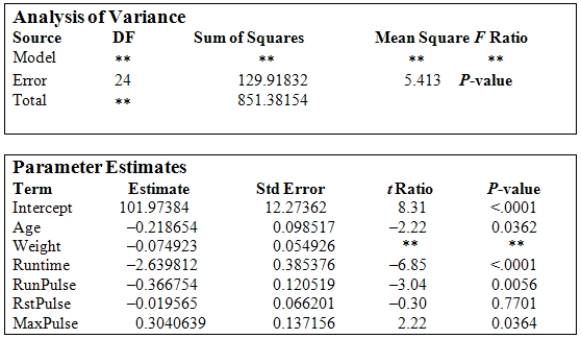Asked by Libby Craig on May 06, 2024

Verified
Data were obtained in a study of the oxygen uptake of 31 middle-aged-males and females while exercising.The researchers were interested in the use of a variety of variables as predictors of Oxygen Uptake.The variables that were measured on the subjects were Age,Weight,the time taken to run a specified distance (Runtime) ,pulse rate at the end of the run (RunPulse) ,their resting pulse rate (RstPulse) ,and their maximum pulse rate during the run (MaxPulse) .The following table from a computer analysis of the data is provided (with some entries deleted and replaced by **) .  In the above computer output we note that the t ratio for the variable RunPulse is -3.04,with a P-value of 0.0056.What is the best interpretation of this result?
In the above computer output we note that the t ratio for the variable RunPulse is -3.04,with a P-value of 0.0056.What is the best interpretation of this result?
A) The small P-value suggests that the variable RunPulse is not a significant predictor of Oxygen Uptake.
B) There is strong evidence that RunPulse is an important variable.
C) When assessing the value of variables for predicting Oxygen Uptake,the variable RunPulse by itself is very important.
D) The small P-value suggests that the variable RunPulse is statistically significant when all the other predictor variables are included in the regression equation.
E) The regression equation should include RunPulse since it is a statistically significant variable.
Oxygen Uptake
The process by which organisms take in oxygen from their environment, essential for aerobic respiration.
P-Value
Broadly, the p-value helps in determining the significance of results when conducting hypothesis testing in statistics, by indicating the probability of observing the results given that the null hypothesis is true, offering a different angle on its importance in statistical analysis.
- Learn about the core principles and how to apply multiple linear regression in investigative studies.
- Pinpoint the constituents of a regression analysis output, encompassing coefficients, R-squared values, and F-statistics.
- Acknowledge the importance of statistical metrics in evaluating model fidelity and the interconnections among variables.

Verified Answer

Learning Objectives
- Learn about the core principles and how to apply multiple linear regression in investigative studies.
- Pinpoint the constituents of a regression analysis output, encompassing coefficients, R-squared values, and F-statistics.
- Acknowledge the importance of statistical metrics in evaluating model fidelity and the interconnections among variables.
Related questions
In This Experiment,the Risk-Taking Propensity of 90 Inner City Drug ...
A Researcher Is Investigating Variables That Might Be Associated with ...
A Multiple Linear Regression Model Can Be Described by DATA ...
In Multiple Regression,what Does the Parameter 2 Measure ...
The Relationship Between the Price of Yachts (Y)and Their Length \(\hat{\text ...